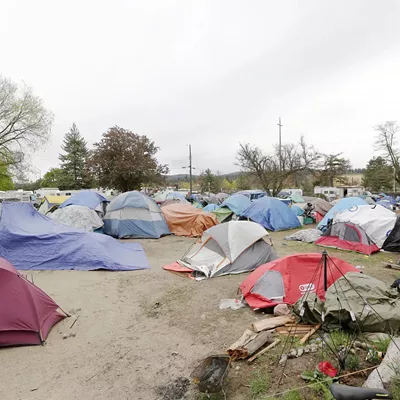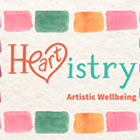That's part of the premise behind "River of Memory: The Everlasting Columbia" (at the MAC from Aug. 25-Jan. 6), which seeks to tell the story of the powerful river before it was harnessed for hydroelectricity. Eileen Klatt's salmon paintings, to be displayed in September and October at the MAC, also harken back to the Columbia of a century ago (see story, page 23).
The photographs for the exhibition were culled from both private and public collections throughout the United States and Canada, including historical societies and the railroad. Some photos are breathtaking, such as an undated image of the Wallula Gateway -- a panoramic view of the austere basalt formations along the Walla Walla River.
Another panorama, of Lower Kettle Falls from 1920, arouses a mixture of awe and sadness. You can almost hear the pounding of water over jutting rocks -- a sound since silenced by the damming of the river. The photo was taken near the site where, in 1940, Native Americans from throughout the Northwest gathered in what was called the "Ceremony of Tears." For three days, tribal members reminisced about and mourned the impending loss of their ancestral fishing grounds, which also served as a cultural focal point for tribes such as the Blackfoot, Coeur d'Alene, Flathead and Colville.
"When fish were running," writes historian William D. Layman, "Kettle Falls was a place of excitement and festivity, drawing more than a thousand people annually." Layman is the driving force behind "River of Memory," which is based on his book of the same name. He has spent more than 25 years researching and writing about such Columbia-related topics as steamboat history and native and pioneer stories. In 2002, he published Native River: The Columbia Remembered (WSU Press). According to MAC exhibition organizer Marsha Rooney, Layman has recently been named a finalist for the Western Writers of America's Spur Award for distinguished writing about the American West.
Layman has described the difference between his earlier book and "River of Memory" by saying that while the earlier book was more historical, this one "goes for the soul of the river." His concept for the exhibition, which debuted at the Wenatchee Valley Museum and Cultural Center last year, included photos, artwork, literature and even music as a means to "invoke a fuller response from viewers ... a mythological understanding of the river." (Audience members, in fact, are encouraged to record their reflections and memories about the Columbia in a blank book provided for that purpose.)
For example, specific exhibition photos were provided as inspiration to a selection of poets like naturalist Tim McNulty, Riverwalking author Kathleen Dean Moore, and Native writer Gloria Bird, a Spokane tribe member and author of The River of History. Layman also chose for the exhibition poems by the likes of Robert Sund, Theodore Roethke and William Stafford (whose daughter Kim's work is also included).
& lt;span class= "dropcap " & F & lt;/span & ish are a primary focus of the exhibition -- which, ironically, is sponsored by Avista and the Bonneville Power Administration, among others. The exhibit is laid out to mimic the river's route -- from the ocean to its origin in British Columbia -- which in turn parallels the salmon's journey. Images of salmon are painted on silk and hang down as reminders of the river's original purpose: habitat. Guiding viewers like signposts through the exhibition, the paintings are the product of illustrators Joseph Tomelleri and Dan McConnell.
Finally, a special soundtrack was created by Dr. Lynette Westendorf, a Methow Valley resident and Emmy Award winner. The music was inspired by the exhibition's photographs and poetry to create what Layman describes as a "sacred sense of space" in the exhibition area.
If he sounds less like a conventional museum curator and more like a holistic healer, that may be due in part to Layman's experience as a mental health counselor. The river has become "dis-membered" in our individual and collective memory, says Layman. So few, he laments, can remember it as a whole river before the hydroelectric dams of the 1930s, nearly 80 years ago.
And therein lies another function of "River of Memory": to honor the Columbia and restore the memory of it to all of us. "Placing each one of [the exhibition's photographs] alongside other photographs taken up and down the river," wrote Layman when the exhibit opened in Wenatchee, "establishes a new appreciation of the whole river, connecting tributaries, mountains and histories to water, earth and sky."
Layman admits that he has strong feelings about the current state of the river. But rather than concentrating on the negative -- the continuing debate over salmon restoration, the mindboggling destruction of habitat, the exploitation of Native peoples -- he chooses instead to focus on the potential for healing.
"Let's honor what was," he says, "so we can better appreciate" what we have now.
"River of Memory: The Everlasting Columbia," opens Saturday, Aug. 25, and continues through Jan. 6, 2008, at the Northwest Museum of Arts & amp; Culture, 2316 W. First Ave. William Layman speaks on "Developing Whole River Understandings: The Columbia River Through Time" on Thursday, Sept. 13, from 6-8 pm. Free. Museum hours: Tuesdays-Sundays from 11 am-5 pm. Museum admission: $7; $5, seniors and students; free, children 5 and younger. Visit www.northwestmuseum.org or call 456-3931.
















